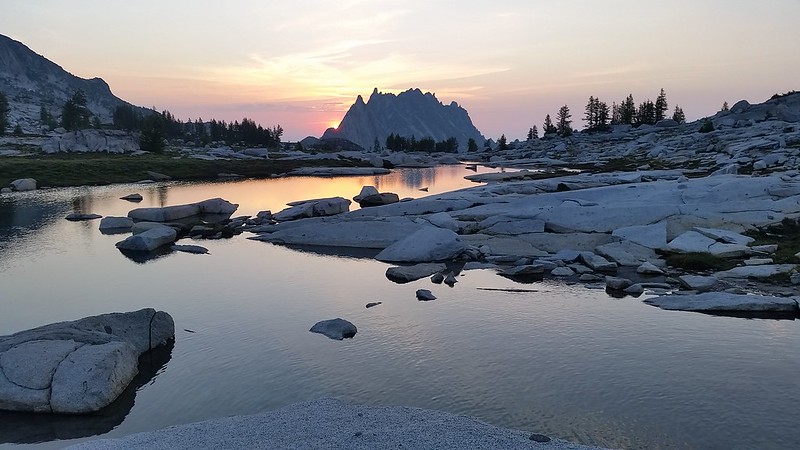The lofty, yet realistic goal for the day would be to reach the summit of Argonaut Peak and bivy somewhere below. The pipe dream was to maybe have enough time and energy to continue on to Sherpa. There is very little beta on the Stuart Range traverse available on the internets, but I had pieced together a few helpful tidbits.
I had initially planned for an alpine start, but after discussing a potential timeline we settled on leaving camp at 5. We ascended Dragontail Plateau from south of the ridgeline, crossing only about 200 feet of snow at the saddle. From the west rim of the plateau we located Colchuck Pass and a few potential lines on the east face of Dragontail's SW ridge. We knew that Pandora's Box would be melted out, and my experience with Colin the year before had us highly motivated to avoid it.
The four of us had been to Dragontail so we bypassed the summit, keeping our eyes on the prize. We boulder-hopped down the valley and chose a ledge just south of the pass. Around 200 feet from the top we reached a low 5th class face with a 3 foot wide chimney to the right. We hauled our bags up behind us and found an easy scramble on the other side. A group of three approached Pandora's Box from Colchuck Peak as we started down into the valley. They quickly decided to abandon Dragontail and returned down the Colchuck Glacier.
We filled up on water where the creek passed under a giant boulder. This is where Argonaut came into clear view and the north face seemed to look like a simple scramble. After getting around a 200'+ clean looking vertical to overhung rib I could see that the ramp we had spotted would go. Colin was pretty sure that we would need to lose at least 800' on the other side to reach the south col, and the northern saddle above was so close we couldn't resist having a look. We had, after all, brought rope and a few pieces of pro.
At the saddle we found a great campsite with views of Argonaut's north face as well as Sherpa and Stuart. The ridge up to the north face look surprisingly mellow despite a steep drop off to the north, but some of the route was obscured so I dropped my pack and headed up the ridge for a closer look. The ridge ended in a butter smooth slab above a narrow col. A small ledge below brought me into the col and seemed to continue to a larger system of grassy ramps. If we could get across the col, the remainder of the climb would be simple. Unfortunately it was filled with several feet of 50+ degree hard snow, and about 10 feet wide where we would need to cross it.
I returned with the bad news and we left our killer campsite behind. We happened across another amazing bivy site with plenty of flat sand to accomodate the four of us and even a grassy pillow for a few. We ascended the ledge and found a few options before us. A few hundred feet above and to climbers left was passable terrain and maybe a route to the summit, but Colin was sure that we would need to lose several hundred more feet to avoid getting cliffed out above. Around 500 feet below, we began traversing and Nick decided his blisters would not allow him to continue.
Rob and Nick returned to camp and Colin and I continued on. Thanks to the GPS we could tell that we were on route in the South Col, but Colin was having a hard time recognizing the terrain, which had been buried in 20+ feet of snow when he was there last. We noted a few potentials return routes that may save us some elevation on the way down. We ascended clean white ledges with a few sketchy moves here and there, and soon enough we were just below the summit looking up at the rap station. We climbed up a very fun chimney choked with chock stones and then inched around an exposed ledge before the final scramble to the top.
It felt great to finally reach the summit, after starting our journey nearly a year ago. We looked down at the ridgetop camp, and half-considered exploring a route down to avoid the extra elevation loss the way we had come. After a short discussion we agreed that we would be better off exploring the higher traverse that we had considered on the south side. We managed to find workable route which saved about 400 feet, but we did opt to rappel down one 40' pitch of low 5th class rock along the way. Colin radioed ahead and as we rolled back into our bivy site just before sunset we were greeted with fresh hot water for dinner.

No comments:
Post a Comment